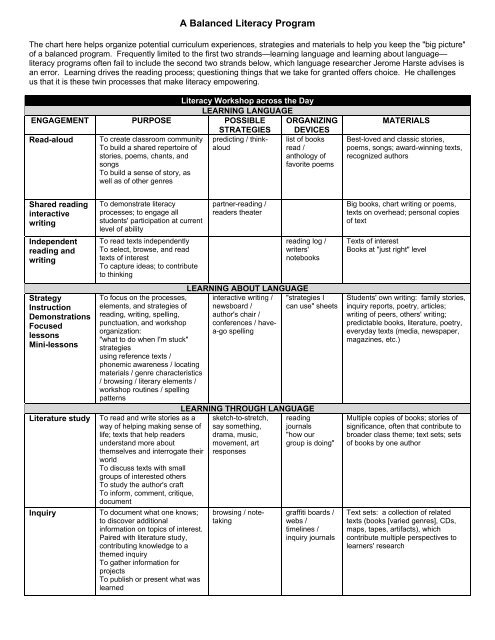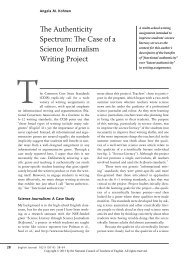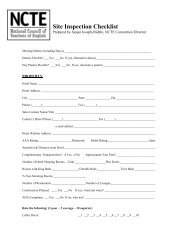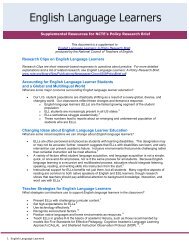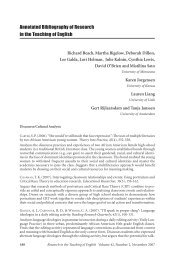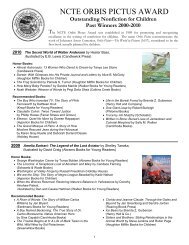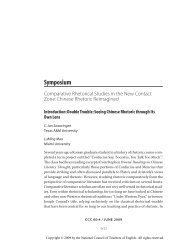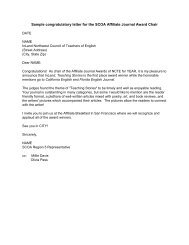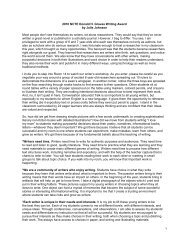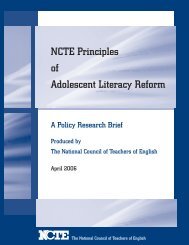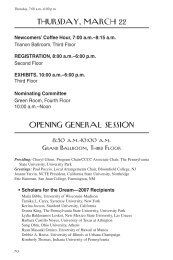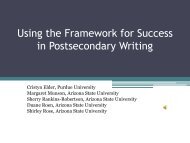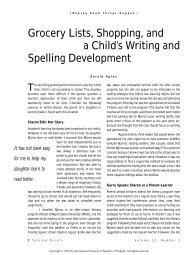A Balanced Literacy Program
A Balanced Literacy Program
A Balanced Literacy Program
Create successful ePaper yourself
Turn your PDF publications into a flip-book with our unique Google optimized e-Paper software.
A <strong>Balanced</strong> <strong>Literacy</strong> <strong>Program</strong>The chart here helps organize potential curriculum experiences, strategies and materials to help you keep the "big picture"of a balanced program. Frequently limited to the first two strands—learning language and learning about language—literacy programs often fail to include the second two strands below, which language researcher Jerome Harste advises isan error. Learning drives the reading process; questioning things that we take for granted offers choice. He challengesus that it is these twin processes that make literacy empowering.<strong>Literacy</strong> Workshop across the DayLEARNING LANGUAGEENGAGEMENT PURPOSE POSSIBLESTRATEGIESORGANIZINGDEVICESRead-aloud To create classroom community predicting / thinkaloudlist of booksTo build a shared repertoire ofread /stories, poems, chants, andanthology ofsongsfavorite poemsTo build a sense of story, aswell as of other genresMATERIALSBest-loved and classic stories,poems, songs; award-winning texts,recognized authorsShared readinginteractivewritingIndependentreading andwritingStrategyInstructionDemonstrationsFocusedlessonsMini-lessonsLiterature studyInquiryTo demonstrate literacyprocesses; to engage allstudents' participation at currentlevel of abilityTo read texts independentlyTo select, browse, and readtexts of interestTo capture ideas; to contributeto thinkingTo focus on the processes,elements, and strategies ofreading, writing, spelling,punctuation, and workshoporganization:"what to do when I'm stuck"strategiesusing reference texts /phonemic awareness / locatingmaterials / genre characteristics/ browsing / literary elements /workshop routines / spellingpatternsTo read and write stories as away of helping making sense oflife; texts that help readersunderstand more aboutthemselves and interrogate theirworldTo discuss texts with smallgroups of interested othersTo study the author's craftTo inform, comment, critique,documentTo document what one knows;to discover additionalinformation on topics of interest.Paired with literature study,contributing knowledge to athemed inquiryTo gather information forprojectsTo publish or present what waslearnedpartner-reading /readers theaterreading log /writers'notebooksLEARNING ABOUT LANGUAGEinteractive writing /newsboard /author's chair /conferences / havea-gospelling"strategies Ican use" sheetsLEARNING THROUGH LANGUAGEsketch-to-stretch,say something,drama, music,movement, artresponsesbrowsing / notetakingreadingjournals"how ourgroup is doing"graffiti boards /webs /timelines /inquiry journalsBig books, chart writing or poems,texts on overhead; personal copiesof textTexts of interestBooks at "just right" levelStudents' own writing: family stories,inquiry reports, poetry, articles;writing of peers, others' writing;predictable books, literature, poetry,everyday texts (media, newspaper,magazines, etc.)Multiple copies of books; stories ofsignificance, often that contribute tobroader class theme; text sets; setsof books by one authorText sets: a collection of relatedtexts (books [varied genres], CDs,maps, tapes, artifacts), whichcontribute multiple perspectives tolearners' research
Social ActionProjectsLEARNING TO CRITIQUE THROUGH LANGUAGETo use language to question questioning /Audit trailwhat seems normal and interrogating / criticalnaturaltalk about booksTo redesign and createalternate social worlds, throughinterrogation of the Internet,media, advertisements, andother everyday texts.Books which supportcritical conversationEveryday textsM.A.K. Halliday (1980) found that in any meaningful language event, children have the opportunity to learn language, learn aboutlanguage, and learn through language. They learn language through the "doing" of language–talking, listening, reading, and writing.They learn about language as they explore how language functions and the conventions that support communication. They learnthrough language as they focus on what it is they are learning. To this we’ve added learning to critique through language (Egawa &Harste, 2001). All four aspects are essential in every classroom. We don't start with one and progress to the next. Rather, it is the fouroperating together within a meaningful context that provides the most balanced and supportive learning environment for literacylearners.


